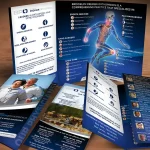In today’s digital age, having a strong online presence is crucial for businesses of all sizes. Digital marketing has become an essential tool for reaching and engaging with customers, driving sales, and building brand awareness. With the increasing reliance on technology and the internet, businesses need to develop effective digital marketing strategies to stay competitive in the market.
Key Takeaways
- Digital marketing is crucial in today’s world for businesses to reach their target audience and stay competitive.
- Developing an effective digital marketing strategy involves understanding your target audience, setting goals, and utilizing various channels such as social media and email marketing.
- Social media marketing can be powerful when done correctly, with tips including creating engaging content, utilizing hashtags, and engaging with your audience.
- Optimizing your website for search engines is important for driving traffic, with tactics such as keyword research and on-page optimization.
- Creating engaging content that resonates with your target audience involves understanding their needs and interests, and utilizing various formats such as blog posts, videos, and infographics.
Understanding the Importance of Digital Marketing in Today’s World
The shift towards digital marketing has been driven by the changing consumer behavior and the rise of technology. More and more people are using the internet to search for products and services, read reviews, and make purchasing decisions. According to a study by eMarketer, 87% of consumers begin their product searches online. This means that if your business is not visible online, you are missing out on a large pool of potential customers.
Furthermore, digital marketing allows businesses to target their audience more effectively. With traditional marketing methods such as print ads or TV commercials, it is difficult to reach a specific demographic. However, with digital marketing, businesses can target their ads based on factors such as age, location, interests, and online behavior. This not only increases the chances of reaching the right audience but also improves the return on investment (ROI) for marketing campaigns.
Developing an Effective Digital Marketing Strategy for Your Business
Developing an effective digital marketing strategy requires careful planning and consideration. Here are some steps to help you create a strategy that will drive results:
1. Define your goals: Before you start implementing any digital marketing tactics, it is important to define your goals. What do you want to achieve with your digital marketing efforts? Is it to increase brand awareness, drive website traffic, generate leads, or increase sales? By clearly defining your goals, you can tailor your strategy to achieve those objectives.
2. Identify your target audience: Understanding your target audience is crucial for creating a successful digital marketing strategy. Who are your ideal customers? What are their demographics, interests, and pain points? By knowing your audience, you can create content and ads that resonate with them and drive engagement.
3. Choose the right digital marketing channels: There are numerous digital marketing channels available, such as social media, search engine optimization (SEO), email marketing, content marketing, and paid advertising. It is important to choose the channels that align with your goals and target audience. For example, if your target audience is active on social media, then investing in social media marketing would be a wise choice.
4. Create compelling content: Content is at the heart of any successful digital marketing strategy. Whether it’s blog posts, videos, infographics, or social media posts, creating high-quality and engaging content is essential for attracting and retaining customers. Your content should provide value to your audience and address their pain points.
5. Measure and analyze your results: To determine the success of your digital marketing efforts, it is important to measure and analyze your results. Use tools like Google Analytics to track website traffic, conversions, and other key metrics. This data will help you identify what is working and what needs improvement in your strategy.
The Power of Social Media Marketing: Tips and Tricks for Success
Social media has become an integral part of our daily lives, and businesses can leverage its power to reach and engage with their target audience. Here are some tips for creating a successful social media strategy:
1. Choose the right platforms: Not all social media platforms are created equal. It is important to choose the platforms that align with your target audience. For example, if you are targeting a younger demographic, platforms like Instagram or TikTok might be more effective than Facebook.
2. Create a content calendar: Consistency is key when it comes to social media marketing. Create a content calendar that outlines what type of content you will post and when. This will help you stay organized and ensure that you are consistently providing value to your audience.
3. Engage with your audience: Social media is not just about broadcasting your message; it’s also about engaging with your audience. Respond to comments, answer questions, and participate in conversations. This will help you build relationships with your audience and foster brand loyalty.
4. Use visuals: Visual content tends to perform better on social media than text-only posts. Use high-quality images, videos, and infographics to capture the attention of your audience and make your posts more shareable.
5. Leverage user-generated content: User-generated content is a powerful tool for social media marketing. Encourage your customers to share their experiences with your brand and use their content in your marketing efforts. This not only helps build trust but also creates a sense of community around your brand.
How to Optimize Your Website for Search Engines and Drive Traffic
Search engine optimization (SEO) is the process of optimizing your website to rank higher in search engine results pages (SERPs). Here are some tips for optimizing your website for search engines:
1. Conduct keyword research: Keyword research is the foundation of any SEO strategy. Identify the keywords that are relevant to your business and have a high search volume. Use tools like Google Keyword Planner or SEMrush to find keywords that are relevant to your industry.
2. Optimize your website structure: A well-structured website is not only user-friendly but also search engine-friendly. Make sure that your website has a clear hierarchy, with important pages easily accessible from the homepage. Use descriptive URLs, meta tags, and header tags to help search engines understand the content of your pages.
3. Create high-quality content: Content plays a crucial role in SEO. Create high-quality, informative, and engaging content that provides value to your audience. Incorporate relevant keywords naturally into your content, but avoid keyword stuffing, as it can negatively impact your rankings.
4. Build high-quality backlinks: Backlinks are links from other websites that point to your website. They are an important ranking factor for search engines. Focus on building high-quality backlinks from reputable websites in your industry. This can be done through guest blogging, influencer outreach, or creating shareable content that naturally attracts backlinks.
5. Monitor and analyze your SEO efforts: Regularly monitor and analyze your SEO efforts to see what is working and what needs improvement. Use tools like Google Search Console to track your website’s performance in search results and identify areas for optimization.
Creating Engaging Content that Resonates with Your Target Audience
Creating engaging content is essential for capturing the attention of your target audience and driving engagement. Here are some tips for creating content that resonates with your audience:
1. Know your audience: Understanding your audience is crucial for creating content that resonates with them. Conduct market research, analyze customer data, and create buyer personas to get a clear picture of who your audience is and what they are looking for.
2. Tell a story: Storytelling is a powerful tool for engaging with your audience. Use storytelling techniques to create compelling narratives that evoke emotions and connect with your audience on a deeper level.
3. Use visuals: Visual content tends to be more engaging than text-only content. Incorporate images, videos, infographics, and other visual elements into your content to make it more visually appealing and shareable.
4. Provide value: Your content should provide value to your audience. Whether it’s educational, entertaining, or inspiring, make sure that your content addresses the pain points of your audience and provides them with actionable insights or solutions.
5. Encourage interaction: Encourage your audience to interact with your content by asking questions, conducting polls or surveys, or hosting contests or giveaways. This not only increases engagement but also helps you gather valuable feedback and insights from your audience.
Leveraging Email Marketing to Build Relationships and Drive Sales
Email marketing is a powerful tool for building relationships with your audience and driving sales. Here are some tips for creating effective email marketing campaigns:
1. Build a quality email list: The success of your email marketing campaigns depends on the quality of your email list. Focus on building a list of engaged subscribers who are genuinely interested in your products or services. Offer incentives such as exclusive content, discounts, or freebies to encourage people to sign up for your emails.
2. Personalize your emails: Personalization is key to effective email marketing. Use segmentation to divide your email list into smaller, more targeted groups based on factors such as demographics, interests, or purchase history. This allows you to send more relevant and personalized emails that resonate with your audience.
3. Create compelling subject lines: The subject line is the first thing that recipients see in their inbox, so it needs to be compelling enough to make them open your email. Use catchy and concise subject lines that create a sense of urgency or curiosity.
4. Provide valuable content: Your emails should provide value to your subscribers. Whether it’s exclusive discounts, educational content, or personalized recommendations, make sure that your emails offer something that is relevant and useful to your audience.
5. Test and optimize: Regularly test and optimize your email campaigns to improve their effectiveness. Test different subject lines, email designs, call-to-action buttons, and sending times to see what works best for your audience. Use analytics and data to track the performance of your emails and make data-driven decisions.
The Role of Analytics and Data in Measuring and Improving Your Marketing Efforts
Analytics and data play a crucial role in measuring the success of your digital marketing efforts and identifying areas for improvement. Here are some tips for measuring and improving your marketing efforts using data:
1. Set up tracking and analytics: Set up tracking and analytics tools such as Google Analytics to gather data about your website visitors, their behavior, and the performance of your marketing campaigns. This data will provide valuable insights into what is working and what needs improvement.
2. Define key performance indicators (KPIs): Define the KPIs that are relevant to your business goals. These could be metrics such as website traffic, conversion rate, click-through rate, or social media engagement. By tracking these KPIs, you can measure the success of your marketing efforts and make data-driven decisions.
3. Conduct A/B testing: A/B testing involves creating two versions of a webpage, email, or ad and testing them against each other to see which one performs better. This allows you to identify the elements that have the biggest impact on your audience and optimize your marketing efforts accordingly.
4. Use data to personalize your marketing: Use the data you gather to personalize your marketing efforts. For example, if you know that a certain segment of your audience prefers video content, you can create more video content to cater to their preferences. Personalization not only improves the customer experience but also increases engagement and conversions.
5. Regularly analyze and optimize: Regularly analyze your data and make data-driven decisions to optimize your marketing efforts. Look for patterns, trends, and insights in your data that can help you identify areas for improvement. Use this information to refine your strategy and make adjustments as needed.
Designing a Website that is User-Friendly and Maximizes Conversions
Having a user-friendly website is crucial for providing a positive user experience and maximizing conversions. Here are some tips for designing a website that is user-friendly and maximizes conversions:
1. Keep it simple: A cluttered website can be overwhelming for users and make it difficult for them to find what they are looking for. Keep your website design clean and simple, with clear navigation and intuitive user interface.
2. Optimize for mobile devices: With the increasing use of smartphones and tablets, it is important to optimize your website for mobile devices. Make sure that your website is responsive and adapts to different screen sizes. This will ensure that users have a seamless experience regardless of the device they are using.
3. Use clear and concise messaging: Your website should clearly communicate what your business is about and what value you provide to your customers. Use clear and concise messaging that is easy to understand and resonates with your target audience.
4. Include strong call-to-action buttons: A strong call-to-action (CTA) button is crucial for driving conversions. Use clear and compelling CTAs that tell users what action you want them to take, whether it’s signing up for a newsletter, making a purchase, or contacting you.
5. Test and optimize: Regularly test different elements of your website, such as headlines, images, CTAs, and page layouts, to see what resonates best with your audience. Use A/B testing to compare different versions of your website and make data-driven decisions to optimize its performance.
The Importance of Mobile Optimization in Today’s Digital Landscape
With the increasing use of smartphones and tablets, mobile optimization has become a crucial aspect of digital marketing. Here are some tips for optimizing your website for mobile devices:
1. Use responsive design: Responsive design is a web design approach that allows your website to adapt to different screen sizes and devices. This ensures that users have a seamless experience regardless of the device they are using.
2. Optimize page load speed: Mobile users have shorter attention spans and are more likely to abandon a website if it takes too long to load. Optimize your website’s page load speed by compressing images, minifying CSS and JavaScript files, and using caching techniques.
3. Simplify navigation: Mobile screens are smaller than desktop screens, so it is important to simplify your website’s navigation for mobile users. Use a hamburger menu or a simple dropdown menu to make it easy for users to navigate your website.
4. Use large and legible fonts: Mobile screens are smaller, so it is important to use large and legible fonts that are easy to read on mobile devices. Avoid using small fonts or fancy fonts that may be difficult to read on smaller screens.
5. Optimize forms for mobile: If your website includes forms, make sure that they are optimized for mobile devices. Use large input fields, minimize the number of required fields, and use autofill features to make it easier for users to fill out forms on their mobile devices.
Staying Ahead of the Curve: Emerging Trends and Technologies in Digital Marketing and Website Design
The digital marketing landscape is constantly evolving, with new trends and technologies emerging all the time. Here are some tips for staying ahead of the curve in digital marketing and website design:
1. Stay updated with industry news: Stay updated with the latest news and trends in the digital marketing industry. Follow industry blogs, attend webinars and conferences, and join online communities to stay informed about the latest developments.
2. Embrace new technologies: Embrace new technologies that can enhance your digital marketing efforts. For example, consider using artificial intelligence (AI) chatbots to provide personalized customer support or virtual reality (VR) to create immersive brand experiences.
3. Experiment with new platforms: Don’t be afraid to experiment with new platforms and channels. For example, consider creating a presence on emerging social media platforms like TikTok or Clubhouse. These platforms offer unique opportunities to reach and engage with different audiences. By experimenting with new platforms, you can stay ahead of the curve and potentially tap into untapped markets. Additionally, consider exploring other channels such as podcasts or live streaming to diversify your content and connect with your audience in different ways. Remember, the key is to adapt and evolve with the ever-changing digital landscape to ensure your brand remains relevant and accessible to your target audience.
Looking for the best web design company in Jackson Heights, NY? Look no further! Bracha Designs is a top-notch web design agency that specializes in creating stunning websites tailored to your business needs. Their expertise in digital marketing website design is unmatched, ensuring that your online presence stands out from the competition. In fact, they were recently featured in an article on their product spotlight for business cards. Check out the article here to learn more about how Bracha Designs can help elevate your brand with their exceptional web design services. And if you’re located on Long Island, they also offer their expertise as the best web design company in the area. Discover more about their services here.
FAQs
What is digital marketing website design?
Digital marketing website design is the process of creating a website that is optimized for digital marketing purposes. This includes designing a website that is visually appealing, user-friendly, and optimized for search engines.
Why is digital marketing website design important?
Digital marketing website design is important because it can help businesses attract and retain customers online. A well-designed website can improve user experience, increase engagement, and ultimately drive more conversions and sales.
What are some key elements of digital marketing website design?
Some key elements of digital marketing website design include a clear and concise message, easy navigation, responsive design, fast loading times, and search engine optimization.
What are some common mistakes to avoid in digital marketing website design?
Some common mistakes to avoid in digital marketing website design include cluttered design, confusing navigation, slow loading times, lack of mobile optimization, and poor search engine optimization.
How can businesses improve their digital marketing website design?
Businesses can improve their digital marketing website design by working with experienced web designers, conducting user testing, optimizing for search engines, and regularly updating and improving their website based on user feedback and analytics.















0 Comments